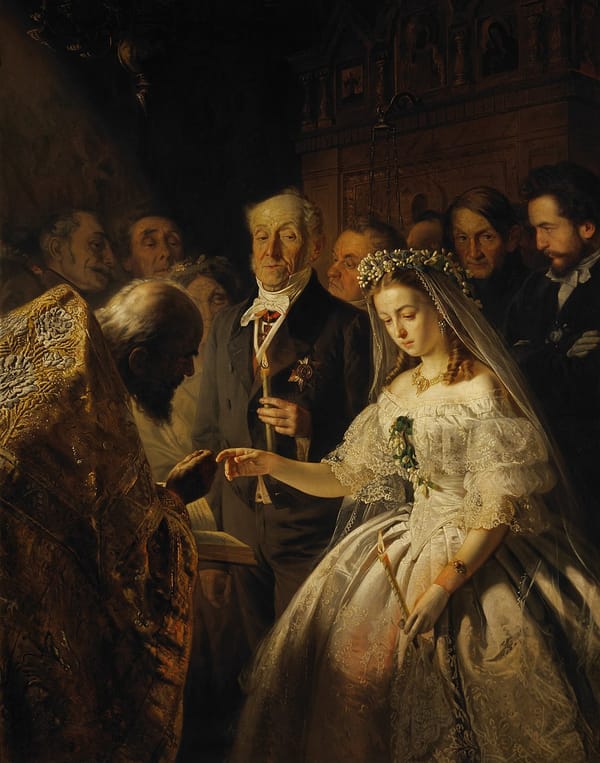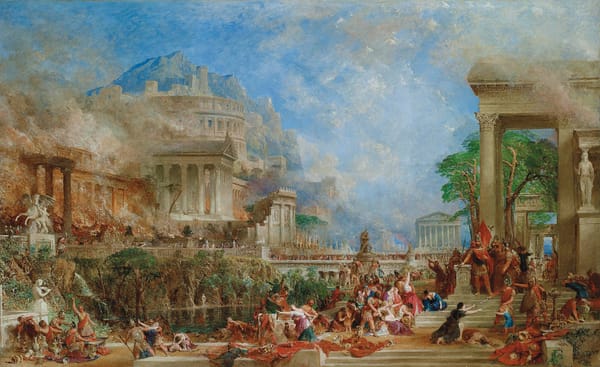Trump L’œil: The White House Ballroom, MAGA Aesthetics, and the Meanings of Trump’s Newest Building Project
Trump, the tacky and chronically bankrupt real estate developer, and Hitler, the failed artist who was too bad at math to try his hand at architecture school, are alike in at least these ways. A love of grand projects papers over fundamental inadequacies.

Donald Trump has destroyed the East Wing of the White House to build his new ballroom. It’s the most expansive remodeling of the White House any president has ever undertaken. And it’s a symbol to many, ally and critic alike, of what this administration represents.
The building itself has been touted by Trump officials like Stephen Miller as a “beautification” project that reflects a wider move toward classical architectural styles. In this sense, the ballroom has been conscripted into a wider MAGA culture war, one in which stamping out degenerate, dangerously heterogenous elements of modern and post-modern art is one more front in the fight to make America great again.
At the same time, Trump’s ballroom project, a massive 90,000 sq ft overhaul of the White House complex that has seen the total destruction of the East Wing and the Jacqueline Kennedy Garden, is a reflection of the man himself.
Of course it is about Trump’s personal power. It’s a claim on one of the most rudimentary symbols of the republic—the people’s house. Trump plans to use this monstrous new facility to dazzle donors and fête the strongmen he so admires. In clear, bold visual language, the ballroom declares “I am the state.”
So I would like to engage in an extended analysis of how the ballroom explains these different aspects of Trump and his authoritarian assault.
Hall of mirrors
It’s worth reiterating just how absurdly, laughably large Trump’s White House addition is. Every rendering we have shows the ballroom dwarfing the rest of the complex. It’s a fitting act of self-aggrandizement for the man Spy magazine famously called a “short-fingered vulgarian” and who boasted (falsely) on 9/11 that the destruction of the World Trade Center meant his tower at 40 Wall Street was now the tallest in New York.
The ballroom is, among other things, another insight into Trump’s wretched, spray-tanned psyche. If Louis XIV built a literal Hall of Mirrors, Trump is erecting a Freudian version.
Donald Trump has never been all that adept at masking his insecurities. His bravado, narcissism, and cruelty have always told the story of a grasping, needy outsider who remains far more famous for playing a successful businessman on tv than for any real executive prowess.
Donald Trump’s entire career has been one of trying to project the man he wants us all to think he is while never being able to conceal the weak, uncultured bully he’s always been. Consider the Trump Taj Mahal, his Atlantic City casino that opened in 1990. At the time, Trump told ABC’s Charlie Gibson that his hotel, absurdly billed as the eighth wonder of the world, was going to be a historic success, saying, “The scale, Charlie, is what brings the people. The opulence, the size, the everything is really what’s going to make the Taj Mahal the most successful hotel anywhere in the world.”
That is Trump’s real theory of greatness in a nutshell: opulence and scale. He has no sense of proportion, no understanding of what qualities others might enjoy beyond overbearing grandiosity. The Taj Mahal closed in 2016 after struggling for years. By then, Trump had parlayed his run on The Apprentice and his role as birther-in-chief into a juggernaut presidential bid.
I am reminded of Hitler’s plans for Germania, his imagined new capital city for the Thousand-Year Reich, when looking at the comically large renderings for Trump’s ballroom. Hitler’s new city would have seen huge swaths of Berlin torn down to accommodate its monumental architecture. He planned a 120-meter tall (over 390 ft) triumphal arch. In addition, the failed painter of dull little Austrian streetscapes planned a 290-meter (over 950 ft) tall great hall with a capacity of 180,000.
Trump, the tacky and chronically bankrupt real estate developer, and Hitler, the failed artist who was too bad at math to try his hand at architecture school, are alike in at least these ways. A love of grand projects papers over fundamental inadequacies.
Aesthetically, the ballroom lives up to Trump’s belief in size and luxury as the most important elements of design. On the outside, the building is set to be a gigantic new piece of neoclassical architecture, an imposing example of the traditional style Trump and his allies insist should be the standard for public buildings across the country. That in and of itself is a deeply political project, one rooted in the culture war that sits at the heart of everything in MAGA world.
Neoclassical façade
Trump and MAGA have been obsessed with remaking Washington and national architecture generally in a style they see as befitting a grand nation of Western inheritance.
Trump’s August executive order proclaims the following:
The Founders, in line with great societies before them, attached great importance to Federal civic architecture. They wanted America’s public buildings to inspire the American people and encourage civic virtue. President George Washington and Secretary of State Thomas Jefferson consciously modeled the most important buildings in Washington, D.C., on the classical architecture of ancient Athens and Rome. They sought to use classical architecture to visually connect our contemporary Republic with the antecedents of democracy in classical antiquity, reminding citizens not only of their rights but also their responsibilities in maintaining and perpetuating its institutions.
It goes on to call for bringing government buildings in line with traditional styles, eschewing more contemporary designs. The order makes clear what does and does not constitute great civic architecture:
(c) “Classical architecture” means the architectural tradition derived from the forms, principles, and vocabulary of the architecture of Greek and Roman antiquity, and as later developed and expanded upon by such Renaissance architects as Alberti, Brunelleschi, Michelangelo, and Palladio; such Enlightenment masters as Robert Adam, John Soane, and Christopher Wren; such 19th-century architects as Benjamin Henry Latrobe, Robert Mills, and Thomas U. Walter; and such 20th-century practitioners as Julian Abele, Daniel Burnham, Rafael Carmoega, Charles F. McKim, John Russell Pope, Julia Morgan, and the firm of Delano and Aldrich. Classical architecture encompasses such styles as Neoclassical, Georgian, Federal, Greek Revival, Beaux-Arts, and Art Deco.
(d) “Deconstructivist architecture” means the style of architecture generally known as “deconstructivism” that emerged during the late 1980s and that features fragmentation, disorder, discontinuity, distortion, skewed geometry, and the appearance of instability …
(g) “Traditional architecture” includes classical architecture, as defined herein, and also includes the historic humanistic architecture such as Gothic, Romanesque, Second Empire, Pueblo Revival, Spanish Colonial, and other Mediterranean styles of architecture historically rooted in various regions of America.
It is true that Jefferson and other Founders drew inspiration from Greece and Rome and promoted the use of classical design elements. However, the MAGA debate over architecture and design is not simply about the promotion of their favorite building styles. It’s about a disgust for the modern and a view of architecture as just one more arena of culture war in which a nativist, utopian, and, most importantly, right-wing ideal of the nation is asserted against a degenerate, poisonous liberalism.
Speaking on Fox News, Stephen Miller made the distinction between Trump and MAGA’s focus on neoclassical architecture and the moral value of modern—essentially liberal, in Miller’s view—architecture and design. As Miller put it, it’s a difference between a right-wing love of beauty that honors America’s cultural heritage and left-wing vandalism that celebrates decay. As he put it:
The scandal is how Democrats and the left have scarred the landscape of our country with grotesque so-called modern art that celebrates ugliness, that celebrates defacement. The tragedy is a political party and a movement that’s ripped down our statues, our monuments, our holidays, our heroes, our heritage. The Republican Party under President Trump celebrates beauty again and beautification again…Very importantly, President Trump is making sure it's in the neo-classical design around which our nation's architecture has long been directed …
It doesn’t much matter that Modernism, Brutalism, the International Style, and other schools of 20th century building and design have had practitioners from across the political spectrum. Modernist giant Le Corbusier, controversial for his associations with Vichy and fascism, warrants a passing mention here.
The echoes in Miller’s tirade against “ugliness” were not lost on observers of right-wing politics. This preoccupation with a binary between noble and “degenerate” forms of aesthetic expression is a hallmark of fascist politics.
The idea that public art that is modern or avant-garde is not only ugly but harmful to the national body was a pet preoccupation of Hitler and other Nazis. Under Hitler and Goebbels’s guidance, the Nazis put on a full show of so-called “Degenerate Art” in 1937, featuring artists like Ernest Ludwig Kirchner and Gerhard Marcks. It’s important to understand that “degeneracy” (or Entartung, to use the Nazi term) was seen as not merely a visual sin but an active threat to the health of the nation. As Charlie English details in his book The Gallery of Miracles and Madness: Insanity, Art, and Hitler’s First Mass-Murder Programme, the Nazis viewed degenerate arts as “degrading [to] the Germans culturally and biologically.”
Even today, as scholar Katrin Schneider has observed, the contemporary German far-right continues to hold the famed Bauhaus movement in contempt. Earlier this year, an AfD member laid the blame for his constituents’ hardships on modernism itself. As Schneider explains:
Hans-Thomas Tillschneider, a member of the far-right Alternative for Germany (AfD) and a member of the regional parliament of Saxony-Anhalt in eastern Germany, has blamed his area's economic problems on Bauhaus modernism.
His unlikely diagnosis came in response to the regional conservative CDU government's "think modern" campaign, which seeks to attract investment into the area and cites the Bauhaus movement as an example of locally grown excellence.
Tillschneider asserts that for the area's economic stagnation to be resolved "we do not need to think modern, we need to think conservatively." He rejects Bauhaus ideas as diffused with communist ideology. With these attacks, Tillschneider has started a quasi-reenactment of a historical culture war over German national identity and social anxieties.
This is not such a different claim from Miller’s insistence that modern buildings depress and discourage people. Modernism, not the rapacious policies of bad men, is what’s plaguing us. Concrete and glass have got you down, not an ethically and economically moronic administration.
Is this too much meaning to put on a building? On one hand, the ballroom is an exercise in classic Trumpian excess and megalomania. This is all typical behavior for a boor obsessed with having the biggest and most expensive things. A gilded, unsightly ballroom dwarfing the rest of the White House is what we expect from the chintzy, pathologically dishonest New York real estate developer.
But Miller’s argument is more totalizing and moral, and it expresses the way MAGA approaches culture war in general—that is, with a fascist posture aimed at the extermination of all elements not seen to be expressing the proper idea of the nation. The neoclassical façade being placed over Trump’s garish warehouse of bribery is precisely the same gloss of ideological purity hardliners like Miller have sought to place over the Trump administration as a whole. In some ways, this is a long-running American tradition, going all the way back to the practice of antebellum plantation owners in the American South building their mansions with classical features in an attempt to plaster a sense of culture and wisdom over the inhuman barbarism of chattel slavery.
But it isn’t modernism or deconstructivism degrading the soul of the American people. It’s not Mies or I.M. Pei or Gehry who have set American culture on a decadent, self-immolating path. It’s the very people driving this administration—people who have sown nothing but bigotry, rapacity, and vice into American life. Their talk of beauty and tradition is about building an America where anyone and anything that doesn’t fit their political and cultural ideal is deemed too ugly and too degenerate for public life.
L’État c’est moi
More than a few commentators have correctly noted that, despite what Trump’s actions imply, the president does not own the White House. But by building a giant temple in which to greet his fawning, tribute-bearing supplicants, Trump has once again asserted that the presidency is merely an engine of his own personal power and wealth.
As my colleague Adam Gurri wrote back in December, part of what makes Trump so dangerous is how he interweaves formal and informal assaults on the law with a cult-like political charisma:
What makes Trump uniquely dangerous as a figure is that he truly does bring all three together the way no president in recent memory could have. None brazenly made use of patronage the way he does, something for which he has faced no consequences whatsoever, proving that he can continue to do so safely. Only Obama could be said to have had any groups to be mobilized through charisma, and he simply used it for the prosaic purposes of winning elections, nothing more. Most men in the history of the "imperial presidency" made use of formalism to attempt to expand their personal power, but few had a pool of talent quite so dedicated to gaming it out as Trump has, and none of them had the ability to buttress this strategy with the other two.
The ballroom is an expression of personalism in absurd, Disneyland style. Chris Hayes summed it up neatly last week: “Donald Trump wants to be a king. That’s the best explanation for everything he’s been doing…Trump wants the White House to be a kingly palace.”
Of course, presidents can renovate the White House and have done so many times. But Trump’s approach of financing his new construction with money from private donors—including Comcast, Lockheed Martin, and the Winklevoss twins—without any say whatsoever from Congress is at best legally dubious. As Hayes argued, the Anti-Deficiency Act “very expressly forbids spending money on government projects that has not been appropriated by Congress…So, it’s truly not clear this is at all legal.”
Legal scholars agree with that assessment, as Bruce Fein told Roll Call:
… private money to build a White House ballroom flagrantly violates the Anti-Deficiency Act, which safeguards the congressional power of the purse by prohibiting the president from using non-appropriated funds donated by private parties for a government purpose indistinguishable from plutocracy.
Informally, Trump has trampled over any sense of public accountability, lying about whether the East Wing would be affected by his ballroom and conducting this huge build during a government shutdown. All of this is in line with a monarchical sense of personal privilege and power.
And the ballroom stands to enhance that power. Trump will surely use the construction process to enrich himself, just as he did with his inauguration. And the space itself will become a premier destination for MAGA acolytes and foreign dignitaries looking to score in America’s new pay-to-play politics.
Trump’s behavior suggests a oneness between himself and the presidency, a sense that it is his rather than an office held in temporary stewardship. And MAGA agrees with this. Trump selling 2028 hats is one thing. But Steve Bannon crystallized the argument, telling The Economist, “Well he’s going to get a third term. So, Trump ‘28, Trump is going to be president in ‘28 and people ought to just get accommodated with that.”
It is tempting to keep dismissing this talk as either flatly illegal or, as one Republican strategist said to The Hill, “just a troll.” But the ballroom project shows just how far short these arguments now fall. Illegality has not troubled Trump in his second term, one where he has an utterly compliant Congress and a staff of sycophants ready to green light his every whim.
And as for it being a troll? Well, that is how so many of Trump’s actions in the last decade have been described—including his run for president.
To return to the ballroom, why build something like this to only get three years out of it? Doesn’t the very process of its construction, the lying and the possibly illegal funding, remind us that Trump sees governmental authority as inextricably linked with his person? Doesn’t his capacity to engage in even more extravagant exercises of patronage, bribery, and extortion through events at this new facility only increase his potential hold on power?
The ballroom is in many ways a watershed moment. Jonathan V. Last has argued persuasively at The Bulwark that the next Democratic president must tear it down. Whether or not it is still standing a few years from now is likely to tell us a little about whether America has managed to successfully resist the assaults of Trumpism.
Featured image is Réception du Grand Condé par Louis XIV (Versailles, 1674), by Jean-Léon Gérôme.




